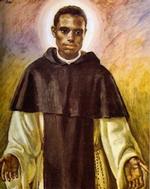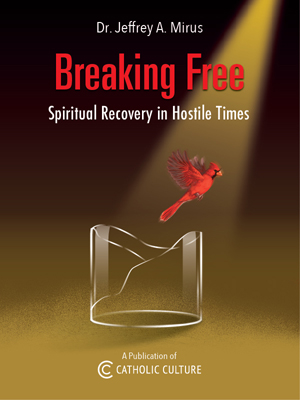Catholic Church's Fight Against Trafficking & Human Slavery
The Catholic Church has assumed a pastoral responsibility to promote the human dignity of persons exploited through trafficking and slavery and to advocate for their liberation and economic, educational, and formative support.
U.S. Ambassadors to the Holy See (formerly Jim Nicholson, and currently Francis Rooney, the sixth and seventh Ambassadors to the Holy See) have made their Embassy prioritize the trafficking in persons and developed important initiatives and training programs. The U.S. Ambassador to the Holy See works closely with the Holy See's other global Nuncios and Ambassadors to link with the Vatican and U.S. government's joint fight against slavery.
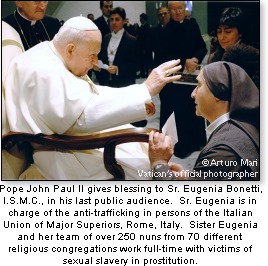
 On October 28, 2005, Pope Benedict XVI issued a message entitled "Migration: a Sign of the Times," written for the 92nd World Day of Migrants and Refugees, to be observed January 15, 2006. Herein Pope Benedict addresses the trafficking in human beings — "a scourge," he says, within the migration phenomenon — and calls for respect for all human beings, especially women's vulnerabilities: "It becomes easy for the trafficker to offer his own 'services' to the victims, who often do not even vaguely suspect what awaits them. In some cases, there are women and girls who are destined to be exploited almost like slaves in their work, and not infrequently in the sex industry too."
On October 28, 2005, Pope Benedict XVI issued a message entitled "Migration: a Sign of the Times," written for the 92nd World Day of Migrants and Refugees, to be observed January 15, 2006. Herein Pope Benedict addresses the trafficking in human beings — "a scourge," he says, within the migration phenomenon — and calls for respect for all human beings, especially women's vulnerabilities: "It becomes easy for the trafficker to offer his own 'services' to the victims, who often do not even vaguely suspect what awaits them. In some cases, there are women and girls who are destined to be exploited almost like slaves in their work, and not infrequently in the sex industry too."
Pope Benedict next echoed the June 29, 1995, condemnation by Pope John Paul II, in "Letter of Pope John Paul II to Women," of the "hedonistic and commercial culture which encourages the systematic exploitation of sexuality and corrupts even very young girls into letting their bodies be used for profit."
Pope John Paul II, Newark, 1995
"The trade in human persons constitutes a shocking offense against human dignity and grave violation of fundamental human rights. Already the Second Vatican Council had pointed to 'slavery, prostitution, the selling of women and children, and disgraceful working conditions where people are treated as instruments of gain rather than free and responsible persons' as 'infamies' which 'poison human society, debase their perpetrators' and constitute 'a supreme dishonour to the Creator' (Gaudium et Spes, 27). Such situations are an affront to fundamental values, which are shared by all cultures and peoples, values rooted in the very nature of the human person. ... Who can deny that the victims of this crime are often the poorest and most defenseless members of the human family, the 'least' of our brothers and sisters? ... The disturbing tendency to treat prostitution as a business or industry not only contributes to the trade in human beings, but is itself evidence of a growing tendency to detach freedom from the moral law and to reduce the rich mystery of human sexuality to a mere commodity."
At a recent June 20-21, 2005, Vatican-sponsored conference, "The First International Meeting of Pastoral Care for the Liberation of Women of the Street," an initiative was written by the Pontifical Council for Migrants and Travelers aimed to offer help and pastoral care to victims, especially in sexual slavery. The document stated the importance of recognizing that sexual exploitation, prostitution, and trafficking of human beings are all grave violations of basic human rights. Archbishop Agostino Marchetto, Secretary of the Dicastery, emphasized the need for the universal Church to get involved by working to recognize victims and rehabilitate them back to their human dignity. The Archbishop said each world bishop needed to place the eradication of human trafficking and slavery as a priority on his agenda.
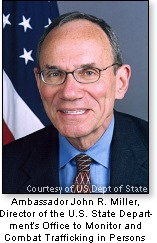 On October 26, 2005, the U.S. Embassy to the Holy See and the U.S. Embassy to Italy co-sponsored a seminar on trafficking in persons at Centro Studi Americani, Rome, entitled "Joining the Fight Against Modern Day Slavery." Ambassador John R. Miller, Director of the U.S. State Department's Office to Monitor and Combat Trafficking in Persons, spoke on the subject of "Putting an End to Trafficking in Persons: A U.S. Priority." The seminar brought together representatives from Italian government and non-governmental organizations, Caritas Internationalis, EU Commission, the Vatican, and the press to meet with the U.S. government's leading expert, Ambassador John R. Miller.
On October 26, 2005, the U.S. Embassy to the Holy See and the U.S. Embassy to Italy co-sponsored a seminar on trafficking in persons at Centro Studi Americani, Rome, entitled "Joining the Fight Against Modern Day Slavery." Ambassador John R. Miller, Director of the U.S. State Department's Office to Monitor and Combat Trafficking in Persons, spoke on the subject of "Putting an End to Trafficking in Persons: A U.S. Priority." The seminar brought together representatives from Italian government and non-governmental organizations, Caritas Internationalis, EU Commission, the Vatican, and the press to meet with the U.S. government's leading expert, Ambassador John R. Miller.
This journalist spoke to Ambassador John R. Miller upon his return from the October Vatican seminar. When asked how the U.S. State Department was specifically working with the Catholic Church on the matter of "human trafficking and slavery," Ambassador Miller replied: "The Catholic Church is already well underway in getting involved in this problem. During my trip, I met with Vatican officials to learn how we can work within the structure of the Catholic Church to end the demand for victims of sex trafficking. We will also work to identify Bishops around the world that are potential allies in the fight against human trafficking and slavery. The challenge for the Church and any institution will be how to translate Pope Benedict XVI and Pope John Paul II's words into action. The challenge will be to get national Episcopal Conferences involved, particularly in education, to warn potential victims. People should be made to understand that it is those men who want acts of prostitution who are creating the demand for sexual slavery. I think the Church will have a special role to play, helping everyone to look at this education issue and helping address demand."
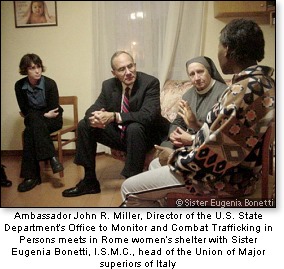 One remarkable person working within the Church is Sister Eugenia Bonetti, M.C., who represents the Italian Union of Major Superiors [USMI] from Rome, Italy. After a 24-year apostolate as a Consolata Missionary Sister in Kenya, Sister Eugenia — a leader of "Orders of Women Religious," now as coordinator of anti-trafficking strategies in Rome — discovered an underworld of human trafficking and slavery while working with illegal immigrants in Turin in 1991. Sister Eugenia coordinates the work of 250 religious nuns from 70 different world congregations working full time in anti-trafficking — helping mostly enslaved women and young girl immigrants who are enslaved in prostitution to regain their freedom and independence.
One remarkable person working within the Church is Sister Eugenia Bonetti, M.C., who represents the Italian Union of Major Superiors [USMI] from Rome, Italy. After a 24-year apostolate as a Consolata Missionary Sister in Kenya, Sister Eugenia — a leader of "Orders of Women Religious," now as coordinator of anti-trafficking strategies in Rome — discovered an underworld of human trafficking and slavery while working with illegal immigrants in Turin in 1991. Sister Eugenia coordinates the work of 250 religious nuns from 70 different world congregations working full time in anti-trafficking — helping mostly enslaved women and young girl immigrants who are enslaved in prostitution to regain their freedom and independence.
Another heroic advocate to free the slaves is Father Oreste Benzi, President of the Pope John XXIII Community, a private international group. Father Benzi told Vatican Radio recently, "Above all, Christians must be conscious of their great responsibility, in virtue of their faith. At present, this is limited to only some sectors of the Church and the whole Catholic Church does not do it. Parish priests and ecclesial movements have a key role to play."
The Vatican Pontifical Council for Migrants and Travelers published a new document from their recent international meeting, "Pastoral Care for the Liberation of Women of the Street," stating the importance of recognizing that sexual exploitation, prostitution, and trafficking of human beings are grave violations of basic human rights.
U.S. Ambassador John Miller pointed this journalist to another good example of the Catholic Church's partnership with the U.S. government, specifically to what happened recently in the Philippines.
Incredibly, during the year 2003 alone, over 80,000 young Filipinas (Filipino women) were legally admitted into Japan as "entertainers" in the Japanese sex industry. These Filipinas enter Japan under the guise of a special "entertainer's visa." Then the women are victimized by traffickers and forced into sexual slavery. Ambassador John Miller took Japan's government to task, asking Japan to willingly look at their own "entertainer's visa" procedures and reduce the number of visas drastically.
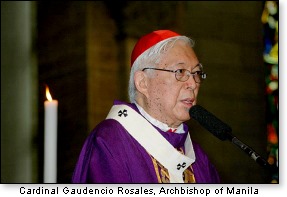 The Philippine government, which has normally provided the U.S. government in the past with helpful trafficking information, suddenly did an about face — realizing how much money it would lose in remittance issues. Not surprisingly, the Philippine government additionally receives over $7 billion annually from the sex "entertainers" who send money back home. Archbishop Gaudencio Rosales of Manila warned the Philippine government that unless they provided enough jobs for Filipinas, these women would always be forced to find employment overseas, enduring painful separation from families. The Catholic Bishops' Conference of the Philippines worked with Ambassador Miller to convince the Japanese government to implement new immigration policies that will bar Filipinas from working in Japan as "entertainers" who are likely to be victimized by traffickers and forced into sex slavery. Moreover, Japan's government willingly complied with U.S. government's suggestion to greatly reduce the number of "entertainer visas."
The Philippine government, which has normally provided the U.S. government in the past with helpful trafficking information, suddenly did an about face — realizing how much money it would lose in remittance issues. Not surprisingly, the Philippine government additionally receives over $7 billion annually from the sex "entertainers" who send money back home. Archbishop Gaudencio Rosales of Manila warned the Philippine government that unless they provided enough jobs for Filipinas, these women would always be forced to find employment overseas, enduring painful separation from families. The Catholic Bishops' Conference of the Philippines worked with Ambassador Miller to convince the Japanese government to implement new immigration policies that will bar Filipinas from working in Japan as "entertainers" who are likely to be victimized by traffickers and forced into sex slavery. Moreover, Japan's government willingly complied with U.S. government's suggestion to greatly reduce the number of "entertainer visas."
Another example of Catholic Church intervention into human trafficking is "The Sisters of Adoration, Slaves of the Blessed Sacrament and of Charity," who operate rescued sex victim's mission centers in Peru, Bolivia, Columbia, India, the Dominican Republic, Japan, and other countries.
In India, there is the "Bal Vikas Ashram," a Catholic rehabilitation center for children aged 8-14 who have been rescued from slavery in Northern India's Uttar Pradesh. Set up in 1999, the project is run by the Catholic Diocesan Development and Welfare Society. The children the Ashram rescues are often found in a miserable condition: they have been forced to weave rugs for 12-15 hours a day, locked in, fed only what it takes to keep them alive, and kept in constant fear in order to prevent them from trying to escape. During 2002, the Ashram carried out 10 raids and freed 78 child slaves.
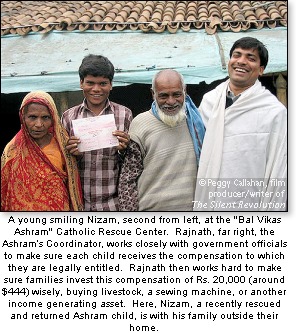 He explains how the center's staff and the others who organized the raid on the carpet factory were determined to capture the slaveholder, as well as free all the children enslaved inside. In order to gain access to the inside of the factory, they told everyone they met in the village that they were from the electric department, and they had come to measure the electricity in use.
He explains how the center's staff and the others who organized the raid on the carpet factory were determined to capture the slaveholder, as well as free all the children enslaved inside. In order to gain access to the inside of the factory, they told everyone they met in the village that they were from the electric department, and they had come to measure the electricity in use.
The slaveholder who was holding the children in captivity had illegally installed an electric water pump motor into the well. So, when the raid took place, his attention was diverted to the pump, which he was frantically trying to remove in order to hide the evidence. In the process of removing the pump, he conveniently fell into the well!
With the slaveholder stuck, the raid team was able to enter the factory and rescue all 13 children. After the children were safe, the team fished the loom owner out of the well.
Now Nizam has returned to live with his 85-year-old great uncle, Sabdul. Sabdul describes how Nizam was tricked away from the village: A slave broker tried to bargain with Sabdul to take Nizam away to work, but Sabdul refused. So the broker chose her moment and lured Nizam away with sweets and promises of a better future. Sabdul went to the police when he could not find Nizam, and they filed a report in the neighboring state, but did not follow up the case. It was not until two years later that Sabdul heard from the Ashram rehabilitation center that Nizam had been rescued and was safe and would be returning home soon.
Nizam still finds it hard to put into words what his experience at the center has meant to him: "My life has changed drastically by going to the Ashram. When I came to tell people in the village that we were all right, I had to explain that I was in a place like heaven. It was hard for them to believe me. I studied at the Ashram and learned tailoring, and now I am teaching tailoring to 50 children at the National Child Labour Project School in the next village. I am going to teach there for about three years, then I plan to open a tailoring shop."
At the center, in addition to literacy, numeric, and vocational training, Nizam absorbed the daily message of the center that children have inherent rights — that slavery is an abuse of their rights, and that every child should have access to education so that they can take control of their future.
It was a message he was determined to bring home to his village, and indeed since he and the other 12 children returned, no more children from his village have gone off to work in slavery. "The slave broker does not even bother visiting any more." (Source: "FreeTheSlaves.net")
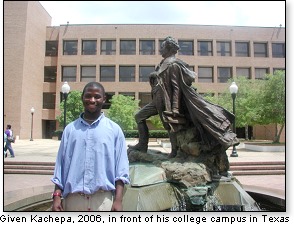 The greatest weapon against human trafficking and slavery is inquisitive neighbors. Read what Given Kachepa, the 19-year-old Zambian (see Given's story in the column entitled "Trafficking in Your Own Backyard") recently said when asked by this journalist what he wanted my readers to understand the most: "I've got my life back because people were willing to look beneath the surface and see my true situation. I want your readers to understand that there are more people out there being used like I was, and if the public is not educated about this, slavery will continue to destroy thousands of lives. Without my African 'chitanga' (shirt) on, I look just like any other person. You cannot tell if a person is a trafficking victim by how they look. The public must 'look beneath the surface' to realize there might be a problem. The public can learn from my story that all people are special and if given the opportunity they can prosper and realize their dreams just like I did."
The greatest weapon against human trafficking and slavery is inquisitive neighbors. Read what Given Kachepa, the 19-year-old Zambian (see Given's story in the column entitled "Trafficking in Your Own Backyard") recently said when asked by this journalist what he wanted my readers to understand the most: "I've got my life back because people were willing to look beneath the surface and see my true situation. I want your readers to understand that there are more people out there being used like I was, and if the public is not educated about this, slavery will continue to destroy thousands of lives. Without my African 'chitanga' (shirt) on, I look just like any other person. You cannot tell if a person is a trafficking victim by how they look. The public must 'look beneath the surface' to realize there might be a problem. The public can learn from my story that all people are special and if given the opportunity they can prosper and realize their dreams just like I did."
The exploitation of the most innocent and vulnerable is caused by a number of contributing factors:
- Unfair and exploitive economic conditions.
- Socio-cultural exploitation.
- Family disintegration.
- Lack of political commitment to addressing the problem.
- Lack of enforcement of existing laws.
- Lack of systematic monitoring and follow-ups.
- Lack of parental education.
- Lack of school education; increase of school dropouts.
- Domestic violence.
- Family in debt.
- Parental discrimination favoring boys over girls.
- Lack of knowledge of human slavery and trafficking worldwide.
- Lack of local governments' monitoring of imported and exported goods labeling system.
- Lack of local governments' monitoring of trade working environments.
- Support the efforts of effective non-governmental organizations, such as "FreeTheSlaves.net" and "Rugmark.org" (additional organizations are listed below under "References") who help provide education to all children in all nations.
- Contact the U.S. Dept. of Health and Human Services hotline: 1-888-373-7888 — which is leading the government fight against human trafficking in the U.S., focusing on rescuing and rehabilitating the victims.
- Contact the U.S. Immigration and Customs Enforcement tip line at: 1-866-347-2423.
- Help to seek legal and medical protection to aid the slaves.
- Sign up for an excellent up-to-date free newsletter at: www.FreeTheSlaves.net/store/
- Join up! Learn how slavery touches your life. Work with others who want to live in a world without slavery. Bring your strength and imagination to ending slavery.
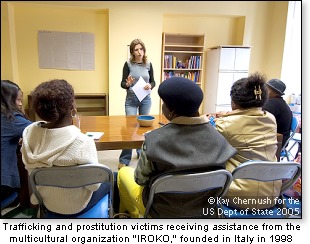
A condensed version was published in the February and April 2006 issue of Catholic World Report.
Read all 16 columns on the subject of Trafficking of Human Slaves by Barbara Kralis at "21st Century Slavery," "Modern Day Slavery Flourishes," "Different Forms of Human Slavery," "Child Sex Tourism," "Slavery as Domestic Servitude," "Combatant Human Slaves," "Involuntary Human Servitude," "Child Slaves for Sport," "Trafficking
Barbara Kralis, the article's author, writes for various Christian and conservative publications. Her columns have been featured at RenewAmerica.us, Catholic World Report, Alliance Defense Fund, Intellectual Conservative, Life Issues, Catholic Culture, The Wanderer newspaper, Phil Brennan's WOW, ChronWatch, North Carolina Conservative, MichNews, Catholic Citizens, Illinois Family Institute, Illinois Leader, New Oxford Review, Seattle Catholic, Faithful Voice, NewsBull, and others. She and her husband, Mitch, live in the great State of Texas, and co-direct the Jesus Through Mary Catholic Foundation. She can be reached at: [email protected].
© 2006 Barbara Kralis
This item 7106 digitally provided courtesy of CatholicCulture.org



